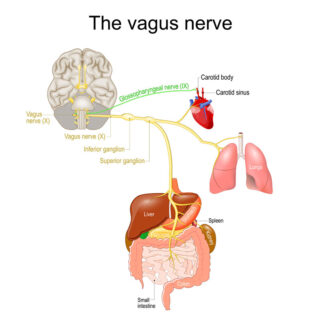
More Weight Control, Nutrition & Exercise Articles
The Gut-Brain Connection: How to Make It Work For You

There is a connection between your gut and your brain. A literal, physical connection: the vagus nerve. It is one of your 12 cranial nerves and it innervates all of its branches into every single part of your digestive system. One very important thing about this highway of communication is that the direction of information flows both ways. Which means: your brain sends signals through this vagus nerve down to your gut, and your gut sends signals back up to your brain.
Brain to Gut
What signal do you want your brain to send to the gut? One of stress: fight or flight? Or one of calm, cool, and collected: rest and digest? How do you want to protect or optimize the state of your mind, in order to get the signal you’re looking for?
This is coming back to everyone’s favorite topic: stress. When you are stressed (in “fight or flight” mode”), your brain sends a message to your body that says, “Hey, we need energy and resources in the limbs of the body because this person needs to run away to safety!” That’s what fight or flight comes from, the evolutionary need to run to safety. The problem in today’s society is that this rarely gets turned off. The message is sent down your vagus nerve and tells your body to divert energy away from the gut. Your brain is telling your body to put energy and resources anywhere but your gut, because to digesting food isn’t important for your safety
So how do you override this when many of us have stress that cannot simply just be removed. So, you have to look at how you can help manage the messages. How can you use a simple tool to create small pockets of space in the day where this message is interrupted and a new one is sent: rest and digest.
Here’s what I recommend:
Create pockets of rest and digest around meal times specifically to support digestion. Deep breathing can reset the nervous system, help you enter rest and digest, and better support digestion. Check out Dr. Huberman’s work on this and the Physiological Sigh. This one simple trick can help you use this gut-brain connection to your advantage.
Gut to Brain
There are a lot of options to support the gut, and therefore the messages being sent to the brain. The overarching idea is that you want to feed the bacteria that produce by-products that impact your brain. You also want to think about how to support the microbiome as a whole so the bugs that you want to thrive have the correct environment to do so.
The bacteria that is the most abundant has the loudest message. Some of you may have experience with candida and may recall the intense cravings for sugar. This is in part because candida thrives off of sugar and carbohydrates so it sends a signal to the brain to feed the gut what it wants the most! Cravings decrease as the candida is being killed off because other organisms are starting to increase and balance things out so that message is less loud.
Resistant Starch
Resistant starch is what it sounds like. It doesn’t get digested so it makes its way all the way into the large intestine where it can serve as a source of food for certain types of bacteria. The by-product of bacteria “eating” resistant starch is something called Short Chain Fatty Acids (SCFAs).
SCFAs are the number one fuel source for the cells that make up the gut lining. The cells of the gut lining utilize short chain fatty acids to help maintain the barrier and protect what comes in and what goes out. SCFAs also have an impact on the blood brain barrier, which means that they have an impact on the brain. These things have an impact on mood, anxiety, your sleep, irritability, and stress – all of these can be impacted simply from eating resistant starch!
What is Resistant Starch?
You can get resistant starch in cooked and cooled rice, white potatoes, and sweet potatoes. You can warm them back up but it’s the cooling process that creates the resistant starch (you know how rice gets sticky when it cools down? That’s the resistant starch.) Green bananas, or green banana flour and white potato starch are also good sources of resistant starch.
If you don’t like or tolerate these foods, you’re going to want to supplement with a resistant starch powder. I recommend Gut Fuel, this is what I use most days (in addition to food sources). It has white potato starch in it + 5 grams of fiber. Brilliant!
Fiber for the Good Bugs
Speaking of fiber – this is the easiest way to break down feeding the microbiome as a whole to support the environment that allows the good bugs to grow and prevents the “bad ones” from overgrowing.
- color – get all of them in
- variety – mix up the fruits, veggies, proteins, nuts/seeds, and grains that you choose
- in-season – nature’s way of reminding you to keep things cyclical
These are 3 SUPER EASY ways you can think about your meals to help ensure you’re feeding the gut a variety of nutrients and fibers. Keep it as simple as possible. Think about what produce is in season, pick a variety of different colors, and then week to week, switch it up. This way you’re naturally getting a variety of different fibers without having to think too much about it. When you get a variety of fibers, you feed a variety of bugs. This will support the gut and the messages it sends to your brain.
Finally, take a look at the Gut-Brain Guide too! You can download it for free HERE and use the tips and tricks to see how far you can impact your digestion and mental state with this alone.
Other Articles You May Find of Interest...
- Ten Lifestyle Habits and Practices for a Healthier Family
- When to Reach Out for Support: Navigating Food Fears with the Help of an Eating Disorder Dietitian
- Five Reasons to run a marathon: Get your trainers on…
- MAY MARKS CELIAC AWARENESS MONTH
- Lifestyle Changes To Lower Cholesterol
- Let’s Get Physical: Making Physical Activity a Part Of Your Family Life
- Bariatric Surgery and Sleep Apnea

















